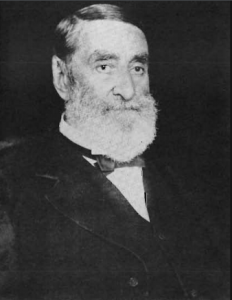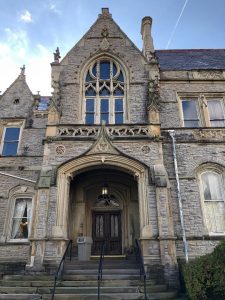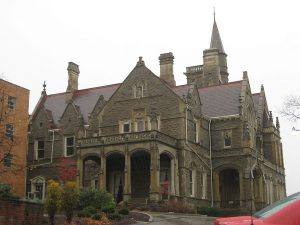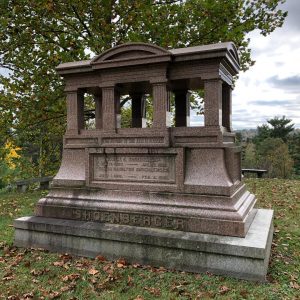By Don Heinrich Tolzmann
Special to NKyTribune
Scarlet Oaks is a beautiful mansion in the Clifton neighborhood of Cincinnati that looks like a castle. A wealthy businessman, George K. Shoenberger (1809-92), had it built after the Civil War. Although his mansion is well known, his family origins most likely are not. They provide a good example of an immigrant success story over three generations of a family.

George K. Shoenberger. Courtesy of Don Heinrich Tolzmann.
George Shoenberger’s grandfather was one of the thirty thousand Hessian mercenary soldiers Britain brought to America during the American Revolution. Many deserted, or remained in the U.S. after the war was over, and George Schoenberger was one of them, settling in Juniata, Pennsylvania. His son, Peter, attended medical school but then went into iron making in the Upper Juniata Valley, which earned him the reputation as “the iron king” of Pennsylvania.
Peter’s son, George K., moved to Pittsburgh and then to Cincinnati in 1834 to open a branch of his father’s company. His business thrived, especially during the Civil War when there was a great demand for iron and steel. By this time, his name had been Americanized to Shoenberger, although it is often spelled the original way. He was highly regarded in the business community, was well known for his philanthropy, and was considered one of the foremost business barons of Clifton.
In addition to running his own business, Shoenberger also served on the board of trustees of the Covington and Cincinnati Bridge Company, which hired John A. Roebling (1806-69) to design and construct the Suspension Bridge on the Ohio River.

Entrance to Scarlet Oaks. Courtesy of Don Heinrich Tolzmann.
He no doubt knew Roebling personally and was well acquainted with the Bridge Company president, Amos Shinkle (1818-92). They had similar backgrounds. Both were wealthy businessmen and had German forefathers who had served during the Revolutionary War (Shinkle’s great-grandfather was a German immigrant and his grandfather a soldier in the Continental Army).
Shoenberger’s obituary in the Cincinnati Enquirer described him as “the most noted of Cincinnati’s social leaders.” It reported: “He amassed a great fortune, and he delighted in giving royal entertainments, in which some of the greatest celebrities of the world participated. He was a man of refined and cultivated taste, and he filled his home with costly and beautiful works of art, collected from all quarters of the globe.” The home was known as Scarlet Oaks because of the many oak trees found on the 47-acre estate.
According to the WPA guide to Cincinnati, the home “had spacious rooms, an indoor fountain, and an outdoor garden that evoked comparisons with the sumptuous homes of European nobility.
Its architect, James Keys Wilson (1828-94), had been sent to Europe to study castles along the Rhine, and then returned and designed the home in the Victorian Gothic Revival style.
Built with blue limestone, Scarlet Oaks was described by D.J. Kenny in his Illustrated Cincinnati as “like some lordly castle of the old feudal times rearing its castellated towers above a lawn of exquisite richness…” The 51-room home included an art gallery, library, and billiard room. European craftsmen were hired to finish its beautiful interior, which includes frescoes and gilded plasterwork. Adolph Strauch (1822-83), Superintendent of Spring Grove Cemetery, completed the landscaping.

Scarlet Oaks. Courtesy of Don Heinrich Tolzmann.
The construction of the Shoenberger home was said to have cost $750,000. His obituary noted that the home “stands upon an eminence overlooking the fertile and picturesque valley, and the view from the Shoenberger mansion is one of the finest to be met within the entire country. In this luxurious and palatial home Mr. Shoenberger gave a large number of receptions and entertainments.” Prior to building Scarlet Oaks, he lived in downtown Cincinnati, and then at an Italianate-style mansion called Inwood on land that was later acquired by the city, and became Inwood Park.
Shoenberger left a substantial estate estimated at $3,000,000 and was interred at an impressive gravesite at Spring Grove Cemetery. After his demise, Ernst Huenefeld (1838-1931), founder of the Huenefeld Company, acquired Scarlet Oaks. An enterprising German immigrant, his company achieved great success by manufacturing the first successful glass door oven. In 1908, he and his wife donated Scarlet Oaks to the Bethesda Hospital and Deaconess Association, a German Methodist institution. It was to be used as a convalescent hospital, as well as a retirement home.
It is now known as the Scarlet Oaks Retirement Community and provides nursing care, rehabilitation, assisted living, and memory care. In 1973, Scarlet Oaks was placed on the National Register of Historic Places and is featured in The Great Houses of Cincinnati by Walter E. Langsam and Alice Weston (1997). Langsam described it as “one of Cincinnati’s most spectacular mansions of the immediate post-Civil War era, as well as a triumph of the American High Victorian Gothic Revival style.”

The Shoenberger gravesite at Spring Grove. Courtesy of Don Heinrich Tolzmann.
Dr. Peter Schoenberger, the son of a Hessian soldier in the American Revolution, became “the iron king” of Pennsylvania, and in like fashion his son became “the iron king” of Cincinnati. All in all an incredible immigrant family success story, and one whose legacy is memorialized by Scarlet Oaks, one of the gems in the crown of the Queen City of the West.
Don Heinrich Tolzmann is a nationally and regionally noted historian of German Americana. He has written and edited dozens of books and contributed to many others, including The Encyclopedia of Northern Kentucky.
We want to learn more about the history of your business, church, school, or organization in our region (Cincinnati, Northern Kentucky, and along the Ohio River). If you would like to share your rich history with others, please contact the editor of “Our Rich History,” Paul A. Tenkotte, at tenkottep@nku.edu. Paul A. Tenkotte, Ph.D. is Professor of History at Northern Kentucky University.
























